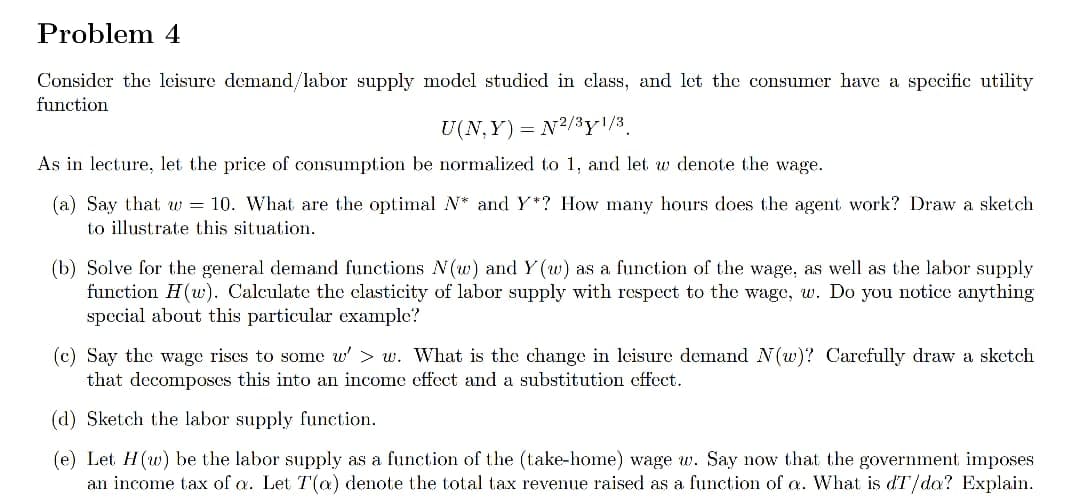Problem 4 Consider the leisure demand/labor supply model studied in class, and let the consumer have a specific utility function U(N,Y) = N2/3y1/3 As in lecture, let the price of consumption be normalized to 1, and let w denote the wage. (a) Say that w = 10. What are the optimal N* and Y*? How many hours does the agent work? Draw a sketch to illustrate this situation. (b) Solve for the general demand functions N(w) and Y(w) as a function of the wage, as well as the labor supply function H(w). Calculate the elasticity of labor supply with respect to the wage, w. Do you notice anything special about this particular example? (c) Say the wage rises to some w' > w. What is the change in leisure demand N(w)? Carefully draw a sketch that decomposes this into an income effect and a substitution effect. (d) Sketch the labor supply function. (e) Let H(w) be the labor supply as a function of the (take-home) wage w. Say now that the government imposes an income tax of a. Let T(a) denote the total tax revenue raised as a function of a. What is dT/da? Explain.
Problem 4 Consider the leisure demand/labor supply model studied in class, and let the consumer have a specific utility function U(N,Y) = N2/3y1/3 As in lecture, let the price of consumption be normalized to 1, and let w denote the wage. (a) Say that w = 10. What are the optimal N* and Y*? How many hours does the agent work? Draw a sketch to illustrate this situation. (b) Solve for the general demand functions N(w) and Y(w) as a function of the wage, as well as the labor supply function H(w). Calculate the elasticity of labor supply with respect to the wage, w. Do you notice anything special about this particular example? (c) Say the wage rises to some w' > w. What is the change in leisure demand N(w)? Carefully draw a sketch that decomposes this into an income effect and a substitution effect. (d) Sketch the labor supply function. (e) Let H(w) be the labor supply as a function of the (take-home) wage w. Say now that the government imposes an income tax of a. Let T(a) denote the total tax revenue raised as a function of a. What is dT/da? Explain.
Chapter7: Uncertainty
Section: Chapter Questions
Problem 7.12P
Related questions
Question

Transcribed Image Text:Problem 4
Consider the leisure demand/labor supply model studied in class, and let the consumer have a spccific utility
function
U(N, Y) = N2/3y!/3.
As in lecture, let the price of consumption be normalized to 1, and let w denote the wage.
(a) Say that w = 10. What are the optimal N* and Y*? How many hours does the agent work? Draw a sketch
to illustrate this situation.
(b) Solve for the general demand functions N(w) and Y(w) as a function of the wage, as well as the labor supply
function H(w). Calculate the elasticity of labor supply with respect to the wage, w. Do you notice anything
special about this particular example?
(c) Say the wage rises to some w' > w. What is the change in leisure demand N(w)? Carefully draw a sketch
that decomposes this into an income effect and a substitution effect.
(d) Sketch the labor supply function.
(e) Let H(w) be the labor supply as a function of the (take-home) wage w. Say now that the government imposes
an income tax of a. Let T(a) denote the total tax revenue raised as a function of a. What
dT/da? Explain.
Expert Solution
This question has been solved!
Explore an expertly crafted, step-by-step solution for a thorough understanding of key concepts.
Step 1: State the given information
VIEWStep 2: Find optimal N* and Y* when w=10
VIEWStep 3: Calculate hours worked, and show it in a diagram
VIEWStep 4: Solve for N(w) , Y(w) and H(w)
VIEWStep 5: Calculate the elasticity of labor supply
VIEWStep 6: Show the effect of rising wage on N(w) using diagram
VIEWStep 7: Sketch the labor supply function
VIEWStep 8: Analyze the effect of tax
VIEWSolution
VIEWStep by step
Solved in 9 steps with 28 images

Knowledge Booster
Learn more about
Need a deep-dive on the concept behind this application? Look no further. Learn more about this topic, economics and related others by exploring similar questions and additional content below.Recommended textbooks for you

